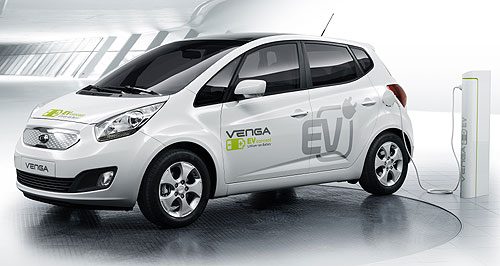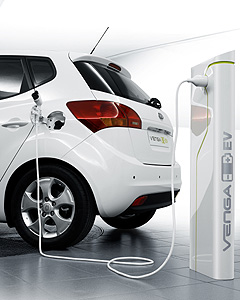Geneva show: Kia lights up with its first EV
BY TERRY MARTIN | 2nd Mar 2010

Taking centre stage in Switzerland alongside the third-generation Sportage compact SUV, the Venga EV demonstrates the ongoing development of an all-electric powertrain that will be used across a range of compact vehicles from both Kia and sister brand Hyundai.
Indeed, the Venga EV is a considerable advancement on Hyundai’s first EV, the i10 Electric, which made its world motor show debut in Frankfurt last September and is scheduled to be produced and leased, in limited numbers, in South Korea in the second half of 2010.
The i10 Electric was shown with a 49kW electric motor and a 16kWh lithium-ion polymer (LiPoly) battery, offering a 160km driving range, 15-second 0-100km/h acceleration and a 130km/h top speed.
The Venga EV, on the other hand, uses an 80kW (and 280Nm) electric motor and a twin-pack 24kWh LiPoly battery.
According to Kia, the car is capable of accelerating from 0-100km/h in 11.8 seconds, on to a 140km/h maximum speed.
The driving range, on a single charge, is claimed to be 180km.

The electric powertrain is located in the Venga’s engine bay, driving the front wheels. The battery pack is located under the boot floor. No other mechanical details are forthcoming at this stage.
“Venga EV represents Kia Motors’ continuing commitment to earth-positive R&D and marks an additional dimension in the company’s development of eco-friendly vehicles,” Kia said.
The EV is identical on the outside to the conventional Venga, a model which is not under consideration for release in Australia.
As GoAuto has reported, Hyundai-Kia is aiming to become one of the top-four global manufacturers of low-emissions vehicles by 2012.
It is embarking on an international rollout of its LPG-electric hybrid drivetrain for the Elantra/Cerato – the latter remaining a prospect for release in Australia – and in August last year announced it would launch its first fuel-cell-powered EV in South Korea before the end of 2012.
This is the same timeframe Hyundai has set for mass-production of the i10 Electric.
Last month, Kia presented the Cerato-based Ray hybrid concept at the Chicago motor show, demonstrating its advanced work on a plug-in petrol-electric powertrain.
The Ray featured an all-aluminium 114kW 1.4-litre direct-injection ‘Gamma’ GDI engine paired with a permanently engaged fixed-ratio CVT used in combination with a 78kW electric motor and LiPoly battery pack.
Kia also used the Geneva show to reveal its new Sportage compact SUV, which goes on sale here mid-year (see separate story), and a low-carbon version of its Cee’d small car, which with a U2-series 1.6-litre diesel engine achieves an 11 per cent reduction in CO2 emissions – down to just 98g/km – over the current cleanest Cee’d.
No timetable for production has been set for the engine, which produces 66kW of power and 235Nm of torque (from 1900-2750rpm), and combines with a six-speed manual gearbox.
Kia points to the engine’s improved software mapping, low-energy variable water pump, particulate filter and high-efficiency alternator, while an idle-stop function, revised gear ratios and a gearchange indicator are also built in. Low-rolling-resistance tyres are used, too.